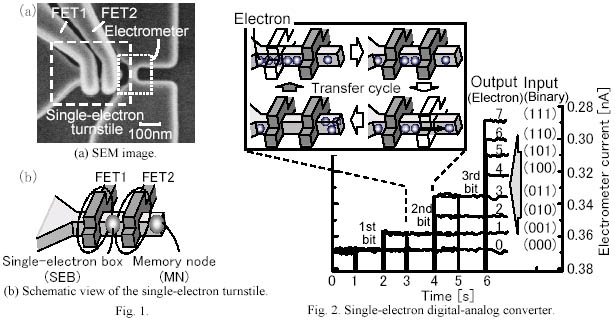Katsuhiko Nishiguchi1, Yukinori Ono1, Akira Fujiwara1,
Hiroshi Inokawa1* and Yasuo Takahashi2
1Physical Science Laboratory, 2Hokkaido University
The single-electron turnstile, which transfers electrons one by one, is promising for ultra-low-power-consuming circuits that treat one electron as 1 bit of information. As a step towards to realize such a circuit, we have successfully demonstrated precise control of electron movement and detection of single electrons at room temperature using silicon nanodevices [1]. In this work, we demonstrated a new data information circuit using this device.
On a silicon-on-insulator wafer, we fabricated the silicon nanodevice, which can transfer and detect single electrons (Fig. 1) [2]. The single-electron turnstile is composed of two wire-FETs. A single-electron box (SEB) is electrically defined between the FETs. By turning on FET1 and FET2 alternately, the single electron is transferred to the memory node (MN) through the SEB (inset of Fig. 2). By repeating this transfer cycle, the electrons are transferred one by one. The single electrons transferred into the MN are detected by an electrometer capacitively coupled to the MN. The electrometer is carefully positioned close to the MN so that the sensitivity of the electrometer is high enough to detect single electrons in the MN.
The size reduction of the SEB and optimization of the operating conditions
provided single-electron transfer with high speed (<10 ns) and precise
detection (0.005 e/Hz0.5) at room temperature. When the number of electrons with one transfer cycle
is adjusted to be 0, 1, 2, or 4, this device serves as a digital-analog
converter, in which binary 3-bit signals are converted to the number of
electrons in the MN and then to eight-level electrometer current. This
is a demonstration of a new application using a single-electron-based architecture
and means that the fabricated device is a basic component that can act
as a bridge between conventional binary signals and single-electron-based
ones.
[1] K. Nishiguchi, et al., International Electron Devices Meeting (IEDM) (2004) 199.
[2] K. Nishiguchi, et al., Appl. Phys. Lett. 88 (2006) 183101.
[3] A. Fujiwara, et al., Appl. Phys. Lett. 84 (2004) 1323.
*Present address: Shizuoka university
 |